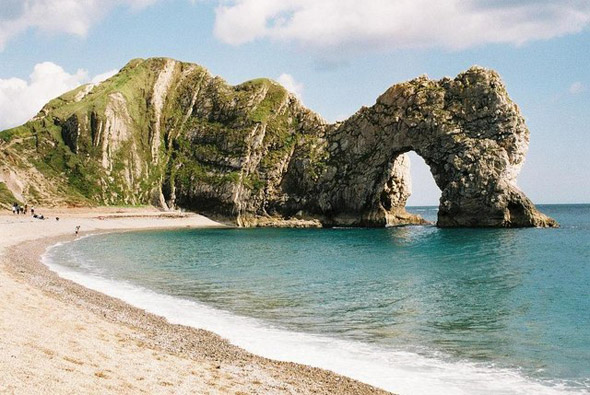West Lulworth
Durdle Door – a lesson in the natural world’s awesome forces.
It must be one of the most remarkable and intriguing formations of the Jurassic coast. Indeed, so curious and intriguing a natural phenomenon that it has been photographed and reproduced as a living-room landscape picture, one reproduction of which hangs above the mantelpiece in the home of a person of my acquaintance.
But Durdle Door, on the Dorset coast about a mile west of Lulworth Cove, is actually not unique as an example of a geological feature of its type around the thousands of miles of mainland Britain’s coastline. Rather, it represents a process similar to an earlier stage in the formation of sea stacks, those columnar outliers off headlands of bedded rock, examples of which include the Needles off nearby Isle of Wight, and Orkney’s Old Man of Hoy. “Door”, of course, needs no explanation, but the name “Durdle” derives from the Old English Thirl, meaning a bore or drill.
An appropriate starting point for the origin of Durdle Door would be around 140 million years ago during the late Jurassic period, when a shallow, warm sea was just beginning to retreat from southern Britain, leaving behind a lake basin which basked in an equatorial climate. The sea left behind a calcareous deposit which would later become the Portland Limestone series, but the lacustrine environment which succeeded it occupied the area that is now south-east England – but extending west to include Dorset of course – into which the sedimentary deposits of the Purbeck Beds were the first to be laid down. Around this lake tropical ferns and coniferous plants would have flourished and in and around the water dinosaurs would have roamed (saurian footprints have been discovered in a Purbeck quarry).
Without any marked change in the environment the Purbeck beds graded into a series of clays and sands marking the beginning of the Cretaceous period. These were the Wealden beds and Lower Cretaceous Gault Clay and Greensand. Eventually the sea encroached upon the land again, resulting in the deposition, first of a sequence of sands and clays then the unique lime-rich conditions in which the chalk was formed. But how did this sequence of beds come to be where they are today?
In a programme a few years ago devoted to Dorset in the ITV 1 series Countrywise, a geologist astonished presenter Paul Heiney when he explained how Durdle Door came to be formed. He told Heiney that the feature had resulted when the northward-drifting continental plate of Africa collided with that of Europe! In the immediate collision zone, the impact produced the Alps and the Pyrennees, but it also sent a shock wave of compressional movement extending as far north as Britain. This was powerful enough to tilt the earlier Jurassic and Cretaceous strata of southern England almost vertical.
At Durdle Bay nearly all of the limestone has long been removed by wave-action, while the remainder forms the facing of a small headland. This limestone band also forms the submarine “threshold” and seaward cusps of Lulworth Cove, which has been eeked out by wave action on the softer stata behind in a similar way to that of Durdle Bay. It is possible that the “door” was originally a local lens of weaker or softer strata within the limestone which the sea could breach more readily, so forming the archway. Evidently the sea was then able to erode away the rock behind, leaving a gap providing access to beds forming the headland.
Beyond the upstanding limestone it is noticeable that the top of the headland that joins the limestone to the Chalk is not level. From the ground it can be seen that the beds form a col or depression which then passes up into the Chalk forming the cliff-face of the bay behind. This rock, the sequence of the Purbeck beds overlain by the Wealden Beds and Greensand, was less resistant to erosion than the limestone. The dominant rock type in the Purbeck beds is the Purbeck Marble, a calcareous rock consisting almost entirely of brackish or freshwater snails and which has been extensively quarried as a decorative building stone. Interestingly, another feature of the Purbeck is the preservation of stumps originally belonging to some of those tree-ferns that used to grow around 140 million years ago. These can be seen weathered out in The Fossil Forest to the east of the entrance to Lulworth Cove.
Today Durdle Door is under the private ownership of the Weld family as part of their administration of the Lulworth estate. UNESCO teams have for some time been working to conserve the arch and adjoining beach.
‘Tapper’ Toms (1854 – 1924)
Henry Thomas Toms grew up to be one of life’s characters. He was known as Harry Toms and later in life acquired the nickname of “Tapper”. Some thought he was a little eccentric; certainly he was one of those old-time independently minded individuals with curious ways we rarely see in our villages today.
He was the son of William Toms, a thatcher from West Lulworth who went to Winfrith Newburgh, a neighbouring village to find a wife. He married Mary Roberts at St. Christopher’s church, Winfrith, on the 8th of October 1833.
William took his bride home to Lulworth and on the 25th of May 1834 their first child Henry was baptised at Holy Trinity Church at West Lulworth. A further ten children would follow: John in 1836, Martha in 1837, Mary in 1838, Joseph in 1841, George in 1843, Sarah in 1846, Jane in 1848, Fanny in 1851. We have not carried out a forensic examination of the family history but it appears the first child Henry and the second child Martha died in infancy and we believe Fanny died aged about 6 years.
Then in 1854 William and Mary had another child they named Henry Thomas. Mary probably thought her days of nursing children were over but she would have been mistaken, because six years later at the age of 45 she again found herself pregnant and in due time a further son, Walter George, arrived. In 1871 Mary Toms then 56 years of age and a widow for these past six years was living in West Lulworth with her sons 16 years-old Henry Thomas and 11 year-old Walter George. Mary passed away in 1880.
Harry Toms worked as a general and sometimes agricultural labourer. It was the custom in those days to lay a neat hedge, but not Harry, who excused his work by saying “I don’t hold wi’ trimming hedge sticks, a good rough hedge ‘ull kip out cows”. Not surprising then, that he was not always fully employed and his work was said to be “average”, perhaps the result of losing his father at a young age before he could learn his father’s trade.
When trimming hedges he always found a walking stick to add to his collection, each stick had a ‘frost’ nail driven into the end of it to prevent slipping. He always used a stick and the noise of the nail on the hard road earned him his nickname – “Tapper”.
He was a man of regular habits and idiosyncrasies. Nightly he would “tap” his way to the Red Lion Inn at Winfrith where he would enjoy some ale and a smoke before setting-off home again, always leaving at 9 p.m. “Tapper”, we are told, never bathed and was often “itchy” and people got used to seeing him rubbing his back against a post. When summer came he would “tap” his way to the sea to wash his shirt, which he would wring out as dry as he could and then put it back on, it was dry by the time he got home. He believed sea water would not give anyone a cold and surprisingly he was always healthy. He told the time by the trains (try doing that today!). People described him as an interesting talker often using words that had long passed out of fashion.
In his later years he was employed on the farm of Mr. George Atwil at Winfrith and he made his home in an empty cow stall. It seems “Tapper” never slept in a bed or ate his meals from a table and he refused both when offered by Mr. Atwil. He would collect his meals from the farmhouse and ate in his cow stall and when he turned-in for the night he would remove his boots and sleep fully clothed covered with old coats in the feeding trough. It seems there was not a woman in Lulworth, Winfrith or Owermoigne who would entertain the prospect of taking “Tapper” for a husband.
We know “Tapper” was working at Atwil’s farm until at least 1916. When he became too old to work he was taken to the Workhouse at Wareham where he died in 1924. He was described as a “queer looking man, short, wiry, rather humped-backed, with busy eyebrows that overhung his sharp little eyes, and a ginger beard, and he wore a trilby hat with its crown always pushed up”.





